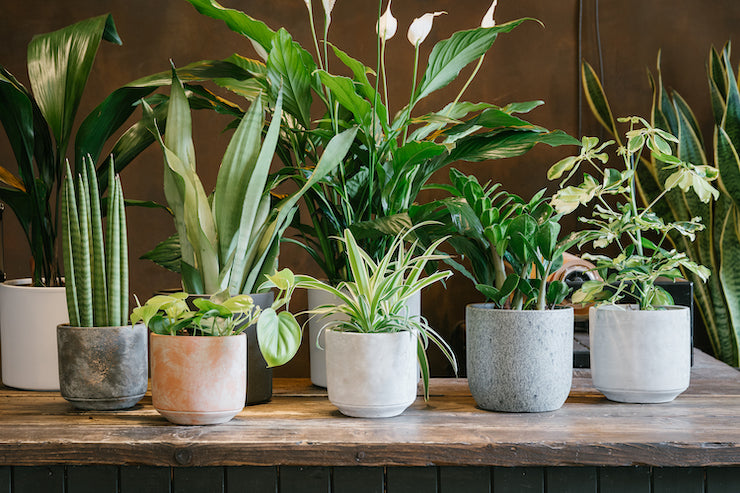
Autumn and Winter Care
What’s not to love about autumn and winter when you can escape from the cold and step into our cosy Edinburgh shops. Soak up the snug jungle vibes at 92 Grove Street or 8b St. Vincent Street. Indulge in a Chai Latte and cake for an extra bit of festive spirit!
The days are shortening and, with the cold weather coming, it’s important to adapt our usual plant care routines to ensure our plantae friends survive the wintery months. The beginning of autumn marks the start of houseplants going through their dormancy period. This means they will begin to put out very little to no new growth and this lasts until the longer days of spring. Our Plant Gurus have put together a few tweaks to your usual routine to keep your plants happy and healthy!
Firstly - stop feeding and avoid repotting. We all feel sorry for our exotic houseplants having to power through a Scottish winter and know how tempting it is to try and give them a wee boost, with a drop of Liquid Gold Leaf, however they are not actively trying to push out new growth over their dormancy period so do not need any extra nutrients that fertilisers provide. Furthermore, certain feeds will crystallise around, and even burn, the roots if added during this period so it is often a good idea to ‘flush out’ any excess fertiliser by fully saturating the compost with water and allowing it to completely drain through.
Avoid repotting your houseplants as the cooler temperatures can shock the root system and can result in stunted future growth. You can resume your feeding routine and any repotting when the growing season begins again in spring! In the meantime, dust leaves frequently to allow for optimum photosynthesis, or use our Organic Focus Leaf Shine to give the foliage a good clean. This will keep leaves looking glossy and act as a fantastic dust repellent to give your houseplants the best chance of surviving the colder days ahead.
Next, think about tweaking your watering schedule. Colder weather will result in compost drying more slowly. It is important to always feel the compost to make sure it is sufficiently dry and ready for its next watering session. If in doubt, our Soil Moisture Meter can be a great option for understanding the moisture levels in the compost. General foliage houseplants tend to like the top inch or two of compost to dry out before re-watering, whilst succulents and cacti like their soil to dry out completely. This means that plants that are usually watered once a week, may now need rewatering every 10 to 14 days. Once a month could change to once every 8 weeks. If you keep your house warmer in the winter, then your watering schedule may not vary as drastically. If you have noticed your plant's upper leaves beginning to yellow this can be a sign of overwatering. Trim back the leaves using a clean, sharp tool, we recommend our Houseplant Pruner or Okatsune Snips, and let the soil dry out for longer before watering next.
Damp soil can also lead to uninvited guests such as Fungus Gnats. A great preventative measure is to try bottom watering, by sitting your plant in water for half an hour, to prevent the topsoil becoming too wet. Fungus Gnats are completely harmless, however can spread quickly as they lay their eggs in the top of the compost. To get rid of these wee black flies replace the top inch of compost. Next, cover the surface with a layer of Decorative Grit to prevent the opportunity to lay more eggs.
Usually, we would be cranking up the central heating at this time of year. Although our tropical houseplants love to stay cosy too, hot radiators and roaring fireplaces can result in dry foliage. If you notice leaves beginning to get brown and crispy be sure to relocate your plants further away from any radiators. Furthermore, whilst rainforests are hot and humid, our central heating can make our spaces very dry so increase your misting to ensure leaves stay lush! In need of a mister? Look no further than our Brown Glass Mister, or treat yourself to The Smethwick Spritzer by Haws. In contrast, draughts can be more of an issue in colder spaces so try to keep your houseplants away from windows and doors to prevent them getting too chilly!
Darker, shorter days result in the constant worry about whether our plants are getting enough light. Usually, the answer is yes, they should survive happily in their designated spot. However, if you notice your plants beginning to get leggy then this is an indication that they may be trying to reach brighter spots. Noticeable changes in colour and variegation are also a sign that your plant pal has noticed there is a lack of light in its usual spot. Simply move them into a brighter space and all will be well!
Run out of bright spots for plant re-positioning? Why not try our brand new Pianta LED Grow Light Bulb from GROWGANG. Designed using Samsung’s latest horticultural LED technology, this bulb emits a warm and natural light that screws into traditional light fittings that allows your plants to thrive without sacrificing your home décor!
Winter can be particularly harsh on our houseplants and it is common for them to lose the occasional leaf over the colder months. Our favourite book for identifying common plant problems is The Plant Rescuer by Sarah Gerrard-Jones. This book offers in-depth analysis of all things houseplant whether it be plant problems, pests plant positioning in the home to help your plants survive and thrive throughout the year!
Follow these top tips to keep your plants happy over the colder months and be rewarded in spring when they begin flourishing again!
Shop our range of easy-care plants for delivery or store collection.



